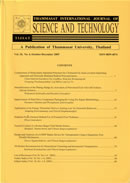ThaiScience
ThaiScience
THAMMASAT INTERNATIONAL JOURNAL OF SCIENCE & TECHNOLOGY
Volume 25, No. 04, Month OCTOBER, Year 2020, Pages 59 - 80
A 3d free surface flow modelling of bypass diversion channel in chao phraya river using large eddy simulation and volume of fluid model
Chartchay Chumchan, Phadungsak Rattanadecho
Abstract Download PDF
The aim of this work is to propose a fully free surface flow modelling technique to a feasibility study of flood prevention by using a bypass diversion channel. This work illustrates a case study in the area of west land of the Chao Phraya River in Ayutthaya City Island, Thailand. A full-scale geometry was created focusing on a simplified terrain model by using the SRTM3 dataset from the year 2000, which has a resolution of about 90 meters on the equator. The bypass diversion channel with 90° was constructed in the Chao Phraya River between Wat Tha Ka Rong and Wat Chaiwatthanaram. The numerical modelling is based on Large-eddy Simulation (LES) and Volume of Fluid (VOF) method that modelling in 3D was validated by using experimental data as partial dam-break flow, dam break in channels with 90° bend, and 90° lateral intake. The present study shows that the river flow in the main river flow can be reduced by using the bypass channel. Moreover, it is found that the formation of the separation zone in junction region that affect flood diversion, however, the length and size of the separation zone can be decreased by modifying the bypass junction shape.
Keywords
LES, VOF, Bypass channel, Dam-break flow, Flood diversion structuresTHAMMASAT INTERNATIONAL JOURNAL OF SCIENCE & TECHNOLOGY
Published by : Thammasat University
Contributions welcome at : http://www.tijsat.tu.ac.th
